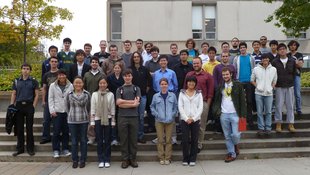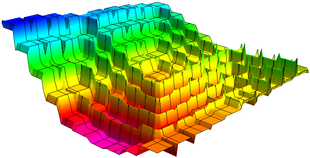10-327/Homework Assignment 7: Difference between revisions
No edit summary |
m (EDIT: moved Kai's HW7 solutions to new page) |
||
| (8 intermediate revisions by 3 users not shown) | |||
| Line 20: | Line 20: | ||
---- |
---- |
||
Questions by Kai [[User:Xwbdsb|Xwbdsb]] 21:26, 19 November 2010 (EST): |
Questions by Kai [[User:Xwbdsb|Xwbdsb]] 21:26, 19 November 2010 (EST) were moved to [[10-327/Classnotes for Thursday November 18|Classnotes for Thursday November 18]] as they are about that class and not about this assignment. [[User:Drorbn|Drorbn]] 06:03, 20 November 2010 (EST) |
||
*Question. If we have a finite set of continuous function mapping from any topological space into the reals. Any linear combination of these continuous function is still continuous right? The proof is a little extension of 157 proof. This is used to prove the statement you mentioned above. -Kai[[User:Xwbdsb|Xwbdsb]] 17:14, 20 November 2010 (EST) |
|||
# I have concern about this "Adding T_1 thing". When we are proving the Urysohn's Lemma, we proved that if X is a T.S. and A,B are any two disjoint closed sets in X, they can be separated by two disjoint open sets in X iff they can be separated by a continuous function. So there is no T_1 axiom involved in any of these two proofs. So Urysohn's Lemma is something more general than T_4 iff T_4.5 right? |
|||
** Any linear combination of functions from <math>\mathcal{C}(X,\mathbb{R})</math> (an uncountable set unless X is empty) is continuous. On its own, however, this proves nothing about infinite sums. [[User:Bcd|Bcd]] 22:32, 21 November 2010 (EST) |
|||
# I just want to also confirm the definition of T_4 and T_4.5: T_4 is T_1 + separation by two disjoint open sets for any two disjoint closed sets and T_4.5 is T_1 + separation by a continuous function for any two disjoint closed sets? |
|||
# The only purpose of this manually adding T_1 thing is that so that T_4 and T_4.5 could imply T_3 T_2 T_1 right? |
|||
*Question about 9. Is J any indexing set? Possibly uncountable? in the hint: A means any closed set? -Kai [[User:Xwbdsb|Xwbdsb]] 22:13, 20 November 2010 (EST) |
|||
# Dror you said before that induction can go up to finite n but why in this case induction will work for a countably infinite set of elements? |
|||
** Yes, <math>J</math> is arbitrary and <math>A</math> is closed. [[User:Drorbn|Drorbn]] 06:41, 22 November 2010 (EST) |
|||
Latest revision as of 22:56, 10 December 2010
| ||||||||||||||||||||||||||||||||||||||||||||||||||||||||||||
Reading
Read sections in Munkres' textbook (Topology, 2nd edition). Remember that reading math isn't like reading a novel! If you read a novel and miss a few details most likely you'll still understand the novel. But if you miss a few details in a math text, often you'll miss everything that follows. So reading math takes reading and rereading and rerereading and a lot of thought about what you've read. Also, preread sections , just to get a feel for the future.
Doing
Solve and submit the following problems from Munkres' book:
- Problem 1 on page 199.
- Problem 1 on page 205.
- Problems 1, 4, 5, 8, 9 on pages 212-213.
Remark. The following fact, which we will prove later, may be used without a proof: If is a topological space and are continuous functions, then the sum is convergent and defines a continuous function on .
Due date
This assignment is due at the end of class on Thursday, November 25, 2010.
| Dror's notes above / Student's notes below |
- Question: In problem 1 p205, is asks us to show that any closed subspace of a normal space is also normal. Do we really need the condition that the subspace be closed? - Jdw
- Yes. Drorbn 19:14, 19 November 2010 (EST)
Questions by Kai Xwbdsb 21:26, 19 November 2010 (EST) were moved to Classnotes for Thursday November 18 as they are about that class and not about this assignment. Drorbn 06:03, 20 November 2010 (EST)
- Question. If we have a finite set of continuous function mapping from any topological space into the reals. Any linear combination of these continuous function is still continuous right? The proof is a little extension of 157 proof. This is used to prove the statement you mentioned above. -KaiXwbdsb 17:14, 20 November 2010 (EST)
- Any linear combination of functions from (an uncountable set unless X is empty) is continuous. On its own, however, this proves nothing about infinite sums. Bcd 22:32, 21 November 2010 (EST)

![{\displaystyle [0,1]}](https://wikimedia.org/api/rest_v1/media/math/render/svg/738f7d23bb2d9642bab520020873cccbef49768d)







![{\displaystyle f_{n}:X\to [0,1]}](https://wikimedia.org/api/rest_v1/media/math/render/svg/d63aafa3453fd31fb01ad87165a4da938d583c98)



